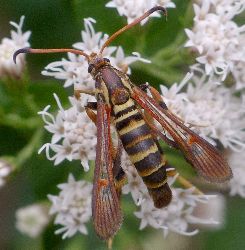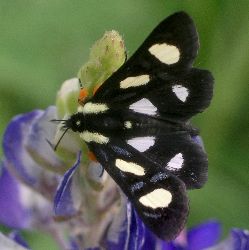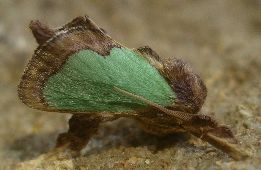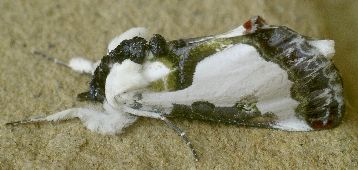
Clearwing
 Clearwing |
Both moths and butterflies are in the same order, called Lepidoptera. This translates roughly to "scaly wings." The scales are what give butterflies and moths their intricate patterns and colors, as well as making them harder to catch because the scales easily come loose, allowing a held insect to literally slip away. Most people want to know how to tell a moth from a butterfly. They are not all that much different. The most reliable way to distinguish the two groups is by their antennae. Butterflies have a knob at the tip of each antenna, while moths' antennae lack this. Moths may have very thin antennae or wide fern-like ones, but they always have a slender tapered tip. Other differences have exceptions. While all butterflies are diurnal (active by day), and most moths are nocturnal, there are also a lot of moths that fly right along with butterflies. Moths are usually heavier and hairier than butterflies, but the latter group can also have these attributes. Many moths are brown, but so are a good number of butterflies. No butterflies fold their wings down like a tent, but there are moths that hold theirs up in a very butterfly-like upright manner.
I think the easiest way to tell the difference between moths and butterflies is to simply learn the butterflies and then all other lepidopterans are moths. While this sounds oversimplified, it does have a sound basis. There are over ten times more moth species than butterflies. All butterflies fit into just six families, whose characteristics are easy to learn. There are a heck of a lot more moth families and they are much more varied.
So if most moths are nocturnal, how can we observe these creatures of the dark? I usually just find them, either by looking carefully and noticing them hiding, or by paying attention to what flies up as I walk. Moths that hide during the day may look like twigs, lichen, dead leaves, or even bird droppings. Some moths adapt unusual postures to help disguise themselves, and will rarely move if disturbed, lest their "cover" be broken. Diurnal moths are easily seen at flowers. These include the large hawk moths that resemble hummingbirds, as well as smaller and sometimes brightly colored species. Some moths mimic wasps in order to be better protected from predators. One excellent way to see more kinds of moths is to look around outdoor lights which attract them. Ultraviolet lights are even better, as moths' vision extends well beyond ours.
 Eight-spotted Forester |
In reality, the adaptations that moths have made to the night are impressive. They tend to have thick body coverings of scales, which often look like fur. This is for heat-retention, so that the warmth generated by their flapping will continue to power the muscles longer. Butterflies have little need of this, as they use sunlight for heat. If cold moths are disturbed, many of them will begin to vibrate their wings, literally warming up the muscles by use of friction. Moths are also quite sensitive to sound. Bats are an important predator of moths, and the moths have evolved ways to recognize bat echolocation calls, sometimes confusing them with their own sounds, but more often performing evasive maneuvers to escape. Because moths do not use visual cues in finding mates, they have instead developed some of the most sensitive chemical detectors in the animal kingdom. Female moths produce pheromones and males use their more elaborate antennae to sense these molecules in the air.
While the vast majority of moths are harmless and cause us no concern, a few black sheep do give the whole group a bad name. Clothes moth caterpillars, tomato hornworms, and budworms are examples that do obvious damage. To be fair, though, the larvae of the cabbage white butterfly, giant swallowtail (the larvae are called orange dogs), and black swallowtail can also be destructive in a garden. An important reminder in moths' favor: the fabric industry would be much different without the domesticated silkworm.
 Oak Slug |  Wood-nymph |
Although moths are often small and brown, the intricacies of their wing patterns can be stunning. The smallest of moths are only about 3 mm long, so tiny that they might look like leafhoppers or just bits of debris. Most moths are in the 1-inch range, which is big enough for human eyes to appreciate. There are, of course, the uncommon giant moths that are bigger than any butterflies. These include the Luna, Cecropia, and Black Witch. Many moths that appear plain brown at first glance are actually patterned as finely as a Persian rug. A little magnification is a big help.
While I enjoy observing all animals, the challenge of identifying moths, with all their amazing diversity, makes them just a bit more entertaining than the average bug.